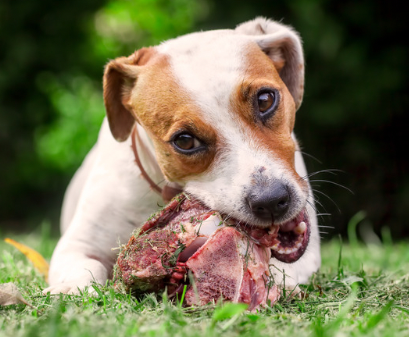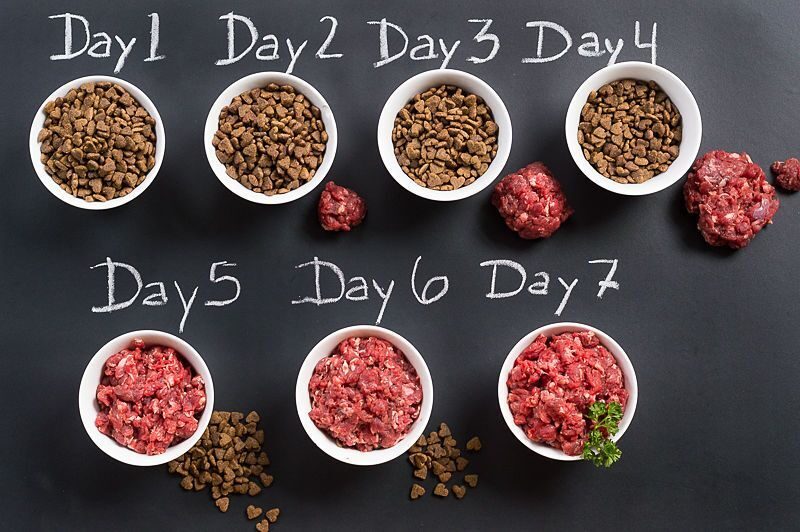
Raw food diets are gaining in popularity with both dog and cat owners, helped along by the increasing selection in commercial frozen raw diets. What are the pros and cons of feeding raw?
PROS
-
Smaller, nearly odorless stool. Because so much of their diet is utilized as nutrition, raw fed dogs produce much less waste than traditional kibble diets. Waste is half the size, dry, well-formed and breaks down much quicker. Especially beneficial for cats and limiting litter box odor.
-
Nutrient rich. Raw is more nutrient-dense and nutritionally complex than cooked pet food because beneficial nutrients and phytonutrients are lost in the cooking process. Most commercial raw food diets contain raw fruits and vegetables (some brands are organic) along with ground up raw bone and organs.
-
No carbohydrates. “Carbs” can contribute to a variety of common health issues: obesity, yeast infections, and diabetes to name a few. Raw diets contain no carbs so it is much easier to control your pet’s weight – and avoid yeast-related issues such as chronic ear infections. Less carbs means less sugar which can also aid in dental health.
-
More moisture. Cats in particular, as a desert-dwelling species, do better when their diet is moisture rich. Increased moisture means less stress on the digestive system. Cats, built to derive moisture from their food, will only drink when they are technically dehydrated. Moisture-rich raw diets help both dogs and cats to avoid urinary tract infections and kidney problems.
-
Ease. Freeze-dried raw is easy to serve (just add water) and does not require refrigeration and is shelf stable. This is especially convenient for pets on the go and traveling with your pet.
-
Good for allergies. Raw food diets are more limited ingredient, which is not only more nutritious, but good for dogs with allergies by eliminating numerous ingredients.
CONS
-
Inconvenient. Raw food must be handled with care similar to that of human food and cannot be left out over 1 hour. Washing surfaces and bowls is necessary daily.
-
Can be more expensive to feed. Whole foods, quality sourcing and limited processing means that pre-prepared commercial raw diets can be more expensive to feed. However often the benefits (and decrease in vet bills) more than make up for the cost differential.
-
Requires refrigeration/freezing. Frozen raw must be kept frozen and refrigerated (daily feeding portion) to ensure safety. This is especially difficult if traveling with your pet.
MISCONCEPTIONS ON FEEDING RAW
#1 MISCONCEPTION: Feeding a raw diet is dangerous due to Salmonella, E. Coli, and Listeria.
The commercial raw diets we carry have a unique food safety procedure to ensure the safety of their products. The most powerful step in this procedure is a high-pressure processing (HPP) step—this is a cold water pressure process that effectively eliminates harmful bacteria from the food. HPP is the only reliable method for maintaining the raw nutrition in these products while removing harmful pathogens. This is the same process used for human foods like cold-pressed juices and guacamole.
#2 MISCONCEPTION: Mixing raw and kibble is bad for my pet's digestive system.
The commercial raw diets we carry are formulated by animal nutritionists and veterinarians and we do not believe that there is any concern when feeding a combination of a kibble and a raw diet. Raw and cooked foods may digest at different rates, though there’s little conclusive evidence to prove this and no scientific evidence saying that they can’t be fed together.
#3 MISCONCEPTION: Feeding a raw diet is not complete and balanced.
The complete commercial raw diets that we carry are AAFCO (Association of American Feed Control Officials) approved and are formulated by animal and veterinarian nutritionists to be complete and balanced nutrition. Raw products that are listed as "toppers" or "mixers" are specifically intended to be used with another food designated as complete and balanced.

We do recommend slowly incorporating raw foods into your pet's diet (or any new food) for ease of digestion. Many pet parents do mix raw food with kibble and consistently have very successful results. Incorporating even a bit of raw food into your dog’s kibble provides a convenient and perhaps more affordable way to begin to give your pet the benefits of a raw diet.
